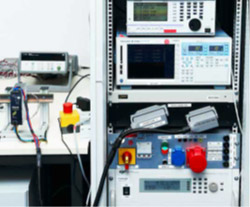
Posted to News on 13th Aug 2019, 11:39
Accurate measurement of power supply efficiency
Bernhard Erdl, Founder, President and Chief Developer of PULS Power, discusses power supply efficiency and why design engineers should be wary of relying on the efficiencies quoted in power supply data sheets.

Modern power supplies are characterised by claims of ever higher efficiencies, but can designers actually rely on the efficiency specifications stated in datasheets provided by manufacturers? How were the values determined, and can an end user make their own measurements and what would be involved in doing so?
More and more system designers are realising that the efficiency of a power supply has a direct influence on its reliability. It is essential - especially in the case of convection-cooled devices - to balance the required dimensions for the power supply against the reliability or end product lifetime. Without additional ventilation, heat can only be dissipated to a limited degree and the designer of a power supply must be very careful to achieve the lowest possible heat generation. Other essential system elements will also benefit from low power losses and minimal heat generation from the power supply.
All power supply manufacturers strive to design high-efficiency products. This article will help users determine efficiency accurately and thus the power losses of a power supply and not have to rely completely on data sheets with scant or sometimes optimistic information.
The following five recommendations should be given highest priority when measuring efficiency and have proved to be essential in practice. They are explained in more detail in this article.
- Use precision meters: If possible, power analysers or highly accurate wattmeters
- Ensure proper cabling when setting up the measurement and that you are measuring the correct voltage
- When taking AC measurements, always use an electronic AC source if available
- Avoid EMC interference from the device under test
- Consider temperature and time influences
Efficiency is a figure that helps designers carry out a proper comparison of different power supplies. However, system designers and users of power supplies are even more interested in the heat which remains in the power supply - i.e. the power losses. Since these power losses cannot be electrically measured in a direct manner, one can only consider the difference between input and output power.
Currently most efficiency values lie at around 95 per cent - this corresponds to a loss of 5 per cent. However small measurement errors in the input and output power lead to large errors when calculating power loss: if there is a measurement error of just 0.5 per cent, i.e. a total of 1 per cent, the power loss calculation would be wrong by 20 per cent (see diagram 1).

It is also important to keep in mind that seemingly small differences in efficiency mean a big difference in power losses. The values for modern power supplies lie between 92 and 95 per cent. The user might have the impression that one or two per cent of difference wouldn't play a big role. However, this is a misconception, because it is not the absolute value of efficiency but rather the difference from the ideal value of 100 per cent that matters most.
As an example for comparable power supplies with 48V/5A output: The PULS QS10 introduced in 2005 has an efficiency of 92.0 per cent. 10 years later, the PULS CP10 is available with an efficiency of 95.5 per cent. At first glance, the difference of "just" 3.5 per cent doesn't seem to be a big improvement. However, the power losses of the CP10 have been reduced by 41 per cent when compared with the QS10 model.
This means that at high efficiencies, even small increases produce a significant reduction in no-load losses. With increasing efficiencies, measurement accuracy keeps gaining in importance, as otherwise it would be impossible to determine no load losses properly.
Determining efficiency accurately and avoiding errors
The closer the developer gets to that perfect efficiency of 100 per cent, the harder it becomes to measure accurately. Absolute measurement precision is therefore essential to give an accurate statement about no-load losses in a power supply. Many errors could be avoided by good preparation and professional measurement. The most common sources of error are:
- Incorrect measurement principle due to unsuitable meters
- Inaccurate meters
- Faulty measurement setup
- Neglecting environmental conditions
Multimeter, wattmeter or power analyser - which is the (measurement) tool of choice?
There are a number of measuring instruments which are used for the determination of efficiency. However, the measurement tolerances and the capabilities of measuring instruments when measuring various signals (AC or DC) vary considerably.
Multimeter: Accurate multimeters do a great job measuring the voltage and current of purely DC inputs and outputs. The voltage can be measured with high precision directly at the input and output of the power supply. Many multimeters also have built-in ability to measure current, but this is usually too inaccurate (inaccuracy of 1 per cent or more) or it does not have sufficient measuring range (usually limited to 10A). Instead, the current should be measured by high-precision shunt resistors with 0.01 per cent tolerance. However the non-synchronous detection of values can be problematic because it leads to errors if fluctuating conditions are present.
Data loggers are even better for DC measurements. They consist of a single, usually highly accurate meter, which is used several times by multiplexing. In the same measuring range, the errors even cancel each other out and all values can be promptly recorded and evaluated quickly with a spreadsheet.
However, AC input power cannot be measured with multimeters or data loggers. It is a common mistake to assume that it is sufficient to measure the true RMS of the current and voltage and to multiply the two values to determine the input power. This calculation, however, determines the apparent power and not the real power which is crucial for the power losses. The measurement of AC input power, even with True RMS multimeters gives incorrect measurements and is an absolute no-go!
Wattmeters are used for measuring AC signals and offer the correct principle. The instantaneous values of current and voltage are multiplied and a mean value is calculated from these products - this corresponds to the physical definition of performance. However, most simple wattmeters have a high measurement inaccuracy (around 1 per cent). Moreover, frequently changing input or output currents (AC input, varying output load) cause additional measuring errors. Fluctuating values are thus difficult to interpret. Generally, only high-precision wattmeters should be used when measuring efficiency.
Power analyser: PULS uses power analysers to measure the efficiency of its power supplies (see image 1). The advantages of this are the high basic accuracy of 0.02 per cent, the correct measuring of active power, the simultaneous and thus synchronous measuring of input and output, and the direct display of power losses and efficiency. The downside of this method of measuring is the high purchase price involved. Nevertheless, the power analyser is the tool of choice for accurate determination of efficiency.

Avoiding mistakes in the measurement setup: A precise and expensive power analyser may, however, not provide accurate results if mistakes were made during the measurement setup.
Correct wiring: All power losses that do not come from the device under test are not allowed to be included in the measurement! This is the main principle when it comes to correct wiring in the measurement setup, because every cable and every contact resistance causes additional power losses that may distort the measurement results. A proper four-pole measurement (Kelvin measurement) must have separate cables for the measurement of current and voltage (see image 2).

Voltage source: Simple DC voltage supplies are sufficient for switch-mode power supplies with DC-input. For AC measurements, it is important to know that the internal resistance of the voltage source influences the measurement through the curve shape of the mains sine. In a 240W power supply without PFC, a difference of 0.4 per cent was measured between the soft power from an isolating regulating transformer and the hard power from an electronic AC source. This gives the most reproducible values and is therefore preferable.
Loads: Not only the power source, but also the load used must be stable and reproducible. The loads from power resistors are problematic because they don't draw a constant current. Electronic loads represent a defined and reproducible load for the device under test and even fluctuating transition resistances do not alter the current.
EMC interferences: Unshielded power supplies in the prototype stage can interfere with meters and/or can cause loads to fluctuate. Measurements should accept no signals with HF interference from meters. Additional filters, mostly inductors in the input lines, prevent these problems. Power losses should not be able to flow into the measurement. There should be no such problems when measuring clean, radio interference-suppressed power supplies.
Taking environmental conditions into consideration
In respect to environmental conditions, temperature plays a decisive role, because the power losses from a power supply are temperature dependent. The temperature of the components in a power supply is a crucial factor. The component temperature is the sum of ambient temperature and self-heating.
Temperature: The various components in the power supply react differently to temperature. In some essential elements an increase in temperature results in a reduction of power losses, and in other components it increases them. The NTCs used for limiting the input inrush current have a strong influence. Power supplies with such components have less power losses when running and in higher ambient temperatures (negative temperature coefficient), because at higher temperatures the increase of power loss is outweighed again by other essential elements (see diagram 2).

Devices with an active input inrush current limiter display a more stable temperature behaviour. Here there is only a small increase in power loss from temperature (see diagram 3).

When taking any efficiency measurement, the running time and the ambient temperature should be documented so that the results remain traceable.
Altitude and air pressure: Since cooling is done by air, the air pressure has an influence on self-heating. PULS has calculated how much additional heat is generated by components at a higher altitude: by approx. + 10degC at an altitude of 2000m above sea level and approx. + 20degC at 4000m. Humidity plays only a very minor role and can be neglected.
Sample distributions: Every component used in a power supply has tolerances and therefore not every device manufactured is the same. But to find genuine errors, PULS measures power losses very closely even during production - although this is not quite as accurate as in the laboratory. A mean value of 95.27 per cent with a deviation of +/-0.15 per cent was measured on a production batch of 200 devices of the model CP10 (see diagram 4).

Requesting accurate efficiency specifications
Rather than designers having to carry out their own measurements it is obviously easier to rely on the manufacturer's specifications - assuming accurate measurements have been taken. Unfortunately, the datasheets for this very important characteristic often contain general statements, such as "up to x per cent efficiency". This is a best-case statement and actually just means that this value is not exceeded. For example, power losses at different mains voltages or loads are not mentioned. Therefore, users who want to know in more detail cannot avoid taking their own measurements. Or else they find another manufacturer who provides full and accurate specifications. But even then, they might feel more reassured if they take one last measurement themselves.
Learn more about PULS and its power supplies at www.pulspower.com.
Want the latest machine building news straight to your inbox? Become a MachineBuilding member for free today >>















